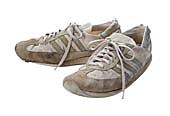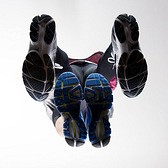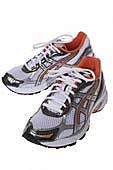Everything You Need To Know About Athletic Footwear.
By Raymond Onyango.
If the shoe fits, then wear it! So goes the old adage, but does this necessarily apply when you’re running on hard tarmac, or dancing your heart out in zumba class or even skipping rope in your house? Can you just strap on any old pair or shoes and ‘get on with it?’ or is there more to it than meets the eye?
As a fitness professional i am often quick to stress that appropriate shoes are the single most important piece of exercise gear, you should acquire, prior to any kind of terrestrial exercise activity. Prolonged use of inappropriate athletic foot wear can lead to an incredible number of muscle imbalances and injuries including strained Achilles tendons, Plantar Fasciitis, Permanent Knee Damage, Hip Fractures and Low Back pain among several other conditions. Think of your body as a sky scrapper, the entire weight of it resting on the tiny surface area of your feet. Now take that sky scrapper out for a walk, or even better – a run; have it bend, jump twist and turn – you can imagine what complex structures your feet must be, in order to cope with all your body’s random movements, without toppling over like a man-made structure would in a similar situation such as an earthquake.
It is precisely this incredible responsiveness added to the constant weight burden of holding up your entire bulk, that make injuries to the feet some of the most common exercise related injuries on the planet. In biomechanical terms, our feet can only do four things: they pronate (roll inwards), they Supinate (roll outwards), they Dorsiflex (pull the toes up towards the shin) and they Plantarflex (point the toes away from the shin). All balances and imbalances in the way we stand, walk or run have their roots in the interplay of these movements.
To choose the correct shoes for you, you need to begin by understanding how your own feet behave. You can do this through a simple method known as the Wet Test. Simply step both into a basin with ½ centimeter or water at the bottom, and then neatly step onto a brown piece of paper, Step off without smudging the feet and observe your footprints. You should be able to glean a lot of information about your foot type.
What is your foot type?
Normal Foot: A normal foot lands on the outside of the heel and rolls inwards slightly, to aid with shock absorption, this will leave a wet foot print which is slightly narrowed at the arch but where the heel is connected to the forefoot by a broad band. Individuals with normal feet do not need any special considerations when buying athletics shoes, save for specificity of the purpose for which they are purchased. If you intend to run, buy running shoes. If you love to hike or go cross country running on uneven terrain – such as forests, coffee plantations or Nairobi’s famously uneven sidewalks, get trail shoes. If you are going to do a little bit of everything; aerobics, weight training, and the occasional outdoor run, invest in Cross Trainers. Having the right kind of shoe will improve your performance, increase your comfort and spare you tons of grief resulting from potential injuries.
Flat Foot: A flat foot, lands on the outside of the heel, but pronates (rolls inwards) excessively, leaving a solid foot print, with little or no discernible narrowing around the foot arches. Over time people with flat feet are likely to incur various overuse injuries including strain to the Medial Collateral Ligaments of the knee, that help to maintain stability in that crucial weight bearing joint. Flat Feet may also present an added problem when the individual in question is overweight, placing the feet under even greater strain.What you need are shoes that help to provide stability to your feet and contain the over-pronation. Shoes labeled “motion control” or “stability” are probably your best fit!
High Arched Foot: A High Arched Foot is sure sign of under – pronation (inward rolling) and the polar opposite of the Flat Foot. The fact that it does not roll inwards enough, makes it a poor shock absorber, which leads to a unique set of problems amongst individuals with this foot type including, frequent occurrence of the ITB syndrome, where the Illiotibial Band spanning the length of your leg and crossing over the three joints including the Hips, Knees and Ankles, becomes irritated, inflamed and morbidly painful, especially when walking down stars or steep slopes. Plantar Faciitis, where the foot arch is strained, collapses or detaches from its attachment at the heel are constant plague to the high arched foot type, as are the heel spurs or bony growth at the site of detachment that often follows in its wake. You need shoes that are well cushioned and allow for plenty of range of motion in the feet. Look out for the words “flexible” or “cushioned” on shoe boxes and, avoid by any means athletic shoes labeled “motion controlled” or “stability” , as these are designed for the Flat Footed type and reduce mobility in the feet, which can only exacerbate your problems.
Other things to consider when purchasing athletic shoes include the time of day. It is wise to buy your shoes in the late afternoon or evening, because your feet expand during the day and are at their widest at this point of the day. If you are running in particular, buy a shoe that is half a size larger in order to guarantee free movement for the toes, which can be a source or numerous attendant conditions, when confined in cramped and poorly ventilated conditions. Some of us may also have imbalances in our feet that require the evaluation of a Podiatrist (foot doctor) and the use of specially designed shoe insoles. Beyond purchasing the correct type of shoes for your feet, you can also look into forms of exercise such as Yoga, will be of tremendous benefit to your feet, by strengthening and gently stretching, the feet arches and Achilles tendons while enhancing your sense of balance and proprioception (awareness of your body in time and space), both of which contribute in no small measure to lowering your susceptibility to incurring injuries of the feet.
Lastly, make sure you buy your shoes in person. Do not send friends overseas to do this for you. When you are present at the shoe store, you can try on the shoes and walk around in order to get a feel of how your feet react to them, before settling on a pair that feels right, you cannot do this remotely over any distance, so be wise!
Have a lovely week will you!






